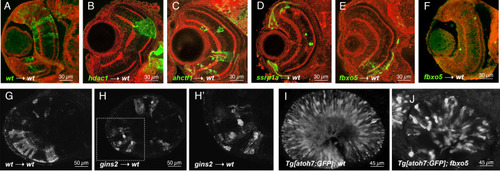- Title
-
Mutations linked to loss of cell cycle control can render cells responsive to local differentiation cues
- Authors
- Cerveny, K.L., Bronstein, H., Hagen, O., Lamb, D.B., Martin, G., Tower, I., Van Duzer, A., Welch, E., Varga, M.
- Source
- Full text @ MicroPubl Biol
|
Figure 1 Survival and/or differentiation of ahctf1, ssrp1a, and fbxo5 mutant cells can be altered by a wild-type developing retinal environment: A-F Representative images of frontal cryosections of 3 dpf chimeric wild-type (wt) retinae containing GFP-labelled wild-type (A), hdac1 mutant (B), ahctf1 mutant (C), ssrp1a mutant (D) or fbxo5 mutant (E-F) cells immunostained for GFP (green cells from donor embryo) and beta-catenin (red cell boundaries and plexiform layers). G-H Lateral views of single 2µm-thick z-plane of whole-mount 3 dpf chimeric wild-type retinae containing wild-type (G) or gins2 morphant (H) cells labeled with membrane-targeted RFP. H’ shows 3x enlargement of boxed region in H. I-J Lateral maximum intensity projection of ~50 hpf retinae from Tg[atoh7:GFP] embryos showing neurogenic gene expression in wild-type (I) or fbxo5 mutant (J) retinae. |

